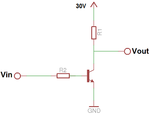Follow along with the video below to see how to install our site as a web app on your home screen.
Note: This feature may not be available in some browsers.
Hi,
the bjt in this common emitter circuit acts like an inverter.
--> use an emitter-follower circuit. But the outut voltages are 0V / 4.4V (instead of 5V) in best case.
Klaus
When i think about it again, your idea is not very good for me because i need to pass high voltage (30V). I thought is not important to mention it but now i think different :bang:Hi,
Why now 30V? You only mentioned 5V...
Generally you can not expect a higher output voltage than your supply voltage.
But in your case it´s worse, because with emitter followers:
--> V_emm = V_base - V_BE = 5V - 0.6V = 4.4V.
Klaus

I don't see how that would work to generate a non-inverted signal. :-?Rather u could use an PNP Transistor to achieve the same ,, the Voltage a the output would be close to 5V depending on how close was it driven to saturation ..